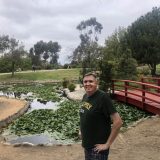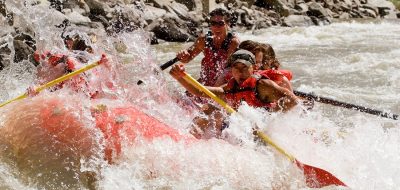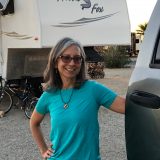By Bob Difley
Many RVers assume that boondocking in Arizona is synonymous with Quartzsite. But there are more than 12 million acres of public land administered by the Bureau of Land Management (BLM) which are open to recreation and camping. So if you are new to boondocking, and find Quartzsite too crowded to stay for long, here are some fascinating locations to explore in the Wild West state of Arizona (from my ebook, Snowbird Guide to Boondocking in the Southwestern Deserts which can be found on my Healthy RV Lifestyle website or for Kindle users at Amazon).
Imperial Dam on the Colorado River is a 3,500-acre BLM LTVA and a popular winter retreat for hundreds of RV snowbirds that visit the southwest corner of Arizona, where the Yuma winter population about doubles the year round residents. Nearby Senator Wash is another BLM camping area. This LTVA has a dump station, water, and trash bins, and near enough to Yuma for convenient shopping, eating out, and cultural events.Mitry Lake Wildlife Area is also near Yuma with nesty, isolated campsites on the cattail covered shoreline of this 600-acre lake. Good place for paddling and birdwatching. Site of Betty’s Kitchen Watchable Wildlife Area and a National Recreation Trail. Ten day limit.Organ Pipe Cactus NM on the Mexico border on AZ-85 south of Ajo is one of the first places in Arizona to see the Spring wildflower bloom. The no hook-up campground takes no reservations and always fills up early, but there is a BLM designated camping area just outside the park boundary south of Why. From this base, a nice desert camping area broken up by dry washes and strips of mesquites and willows, you can make day trips to the park. Also a good area for birdwatching, including three species of orioles that will visit your campsite if you stick half an orange on a mesquite thorn.Several widely scattered, designated, free primitive campsites in the Buenos Aires NWR south of Tucson near the Mexico border at Sasabe offer a boondocking base for exploring the world class birding areas of Arivaca Creek and Arivaca Cienega, as well as the quirky remote artist enclave town of Arivaca.The area east from Buenos Aires NWR to Bisbee is an especially interesting one for early Arizona and Wild West history, including the historic town of Tombstone where the Gunfight at the OK Corral took place (and is still re-enacted today), and the reinvigorated copper mining ghost town–and artist colony–of Bisbee.Southeastern Arizona, east of I-19 (the only US highway to have metric mileposts) and south of I-10 from Tucson to the Mexico and New Mexico borders, is a unique area with scattered boondocking sites both on BLM land and in patches of Coronado National Forest. Known for its premier birding sites, it includes the BLM’s visitor center on the San Pedro River (called one of the “World’s Last Great Places” by the Nature Conservancy and where the Southern Arizona Bird Observatory (SABO) conducts birding hikes and hummingbird banding , the forested species-diverse sky island mountain ranges, some last remnants of Arizona savanna grasslands where you may spot pronghorns, and some very old pre-historic Indian sites.Watch and listen to thousands of croaking Sandhill cranes on their wintering grounds (photo) at Willcox Playa. A celebration of the cranes return, called Wings Over Willcox, is held each January.There are, of course, many other dispersed camping and boondocking locations throughout the desert areas of Arizona as indicated on this map.
Imperial Dam on the Colorado River is a 3,500-acre BLM LTVA (photo) and a popular winter retreat for hundreds of RV snowbirds that visit the southwest corner of Arizona, where the Yuma winter population about doubles the year round residents. Nearby Senator Wash is another BLM camping area. This LTVA has a dump station, water, and trash bins, and near enough to Yuma for convenient shopping, eating out, and cultural events.
Mitry Lake Wildlife Area is also near Yuma with nesty, isolated campsites on the cattail covered shoreline of this 600-acre lake. Good place for paddling and birdwatching. Site of Betty’s Kitchen Watchable Wildlife Area and a National Recreation Trail. Ten day limit.
Organ Pipe Cactus NM on the Mexico border on AZ-85 south of Ajo is one of the first places in Arizona to see the Spring wildflower bloom. The no hook-up campground (photo) takes no reservations and always fills up early, but there is a BLM designated camping area just outside the park boundary south of Why. From this base, a nice desert camping area broken up by dry washes and strips of mesquites and willows, you can make day trips to the park. Also a good area for birdwatching, including three species of orioles that will visit your campsite if you stick half an orange on a mesquite thorn.
Several widely scattered, designated, free primitive campsites in the Buenos Aires NWR south of Tucson near the Mexico border at Sasabe offer a boondocking base for exploring the world class birding areas of Arivaca Creek and Arivaca Cienega, as well as the quirky remote artist enclave town of Arivaca.
The area east from Buenos Aires NWR (photo) to Bisbee is an especially interesting one for early Arizona and Wild West history, including the historic town of Tombstone where the Gunfight at the OK Corral took place (and is still re-enacted today), and the reinvigorated copper mining ghost town–and artist colony–of Bisbee.
Southeastern Arizona, east of I-19 (the only US highway to have metric mileposts) and south of I-10 from Tucson to the Mexico and New Mexico borders, is a unique area with scattered boondocking sites both on BLM land and in patches of Coronado National Forest. Known for its premier birding sites, it includes the BLM’s visitor center on the San Pedro River (called one of the “World’s Last Great Places” by the Nature Conservancy and where the Southern Arizona Bird Observatory (SABO) conducts birding hikes and hummingbird banding , the forested species-diverse sky island mountain ranges, some last remnants of Arizona savanna grasslands where you may spot pronghorns, and some very old pre-historic Indian sites.
Watch and listen to thousands of croaking Sandhill cranes on their wintering grounds (photo) at Willcox Playa. A celebration of the cranes return, called Wings Over Willcox, is held each January.
There are, of course, many other dispersed camping and boondocking locations throughout the desert areas of Arizona.
For more RVing articles, destinations, and tips take a look at my Healthy RV Lifestyle website, where you will also find my ebooks: BOONDOCKING: Finding the Perfect Campsite on America’s Public Lands (PDF or Kindle), 111 Ways to Get the Biggest Bang for your RV Lifestyle Buck (PDF or Kindle), and Snowbird Guide to Boondocking in the Southwestern Deserts (PDF or Kindle), and The RV Lifestyle: Reflections of Life on the Road (PDF or Kindle reader version). NOTE: Use the Kindle version to read on iPad and iPhone or any device that has the free Kindle reader app.







Pingback: hcg diet
Sondra Blair-Bond
Can you give us updated info on Ajo, AZ., Lukeville, and crossing into Mexico to visit Puerto Penasco. We have had warnings here in Tucson of violence and unsafe conditions.
Thanks,
Sondra
ann Marcus
The picture posted is of Jim at Senator Wash BLM land. I snapped that picture and put in on my blog where you apparently got it.
Ann and Jerry